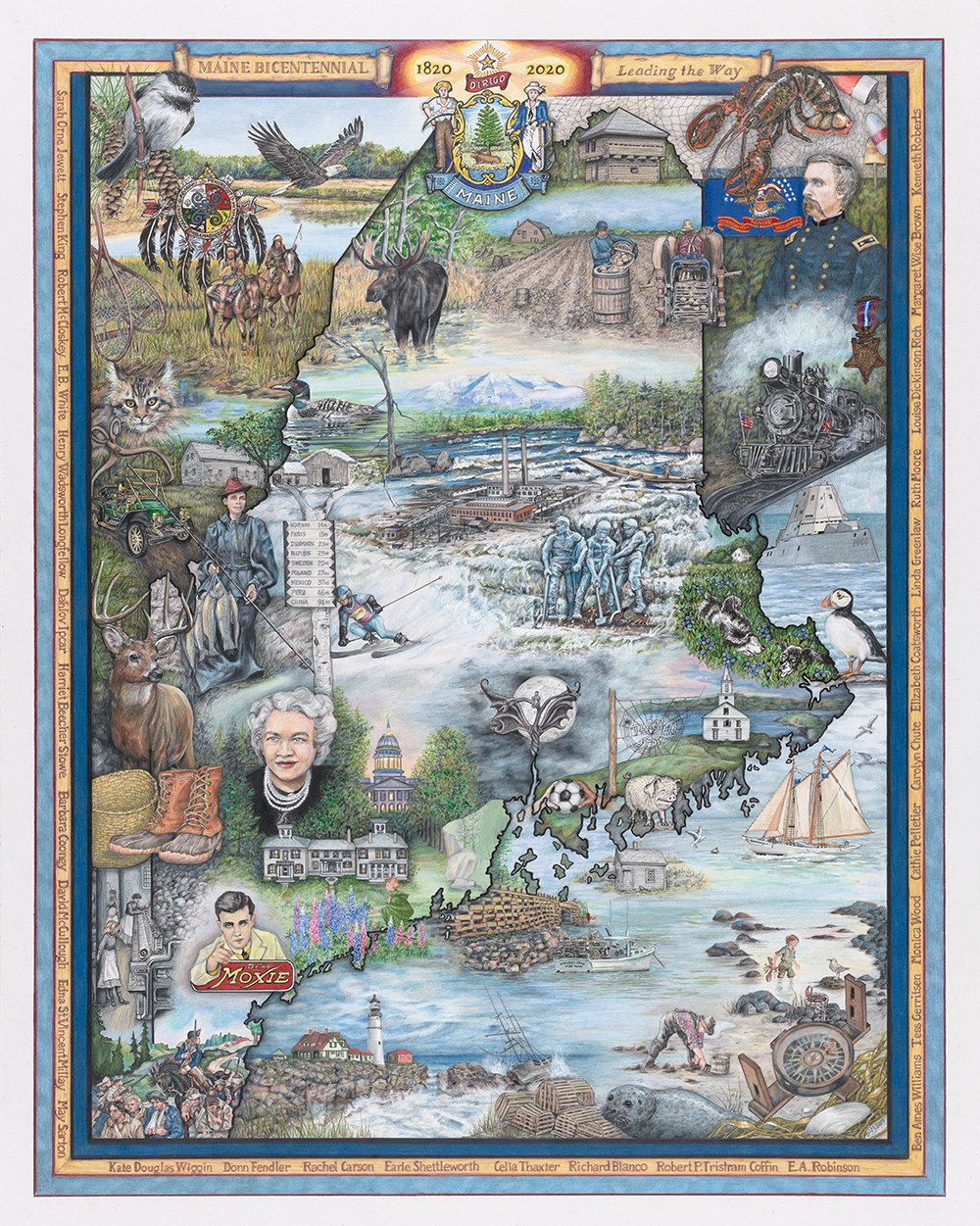Home → Maine Bicentennial → Maine Literary Map
1820 The Bicentennal Map of Maine
This is a description of the illustration by Deborah L Merrill who currently lives in Brownfield, Maine but spent 30 years in Pine Point, Scarborough.
Inspired in part by the many authors the Maine State Library chose to be represented, this map weaves iconic Maine individuals and images along with numerous literary references.
In the left corner is the state bird- the chickadee and white pine, the state tree. The Wabanaki Confederacy symbol for the Indian tribes (early 1600's and revived in 1993) who inhabited most of what is now Maine meant "People of the First Light."
In the right corner is Joshua Chamberlain; professor, brigadier general and governor of the state, who had gone off to fight in the civil war to the south- (his original Medal of Honor pictured was just recently found for his impact in the Battle of Gettysburg.) In the lower left corner, is the cover from Rabble in Arms representing our sons and daughters who have fought bravely and have made huge contributions to our country and continue to do so.
The County is represented by an industry it is known for, and represented as well, is the Fort Kent blockhouse which is the only surviving American blockhouse that was built as border tensions heightened during the Aroostook War.
Starting with Mount Katahdin, the river bends around showing a bateau in the current. The river drivers, (the Luther Pierce memorial: "The Last Drive" statue, located in Bangor) depict legendary river drivers using an ax, a cant-dog, and a peavey. Until the arrival of the railroads, the rivers were the means with which to get the logs from the forests to the mills. Great Northern Mill is pictured in the middle with a scene from a typical textile mill and underage worker in the lower left corner. Many of our towns in Maine grew from mill locations outward.
The steam locomotive changed the way in which the logs were transported and how paper and wood products also made it to the rest of the country. Trains also enabled tourism to grow. Fly Rod (Cornelia) Crosby was an early "marketer" of Maine- promoting the use of the railroads. She made the Maine backwoods near Rangeley and other Downeast locales a mecca for out of state hunters and fishermen. She was the first Maine guide and played a huge role in promoting catch limits and seasons as well as licensing guides, fishermen and hunters.
There is a typical New England farm where the buildings are attached. Also, the Maine coon cat, and the Stanley Steamer, a steam powered motorcar (produced 1902-1924) which set the world record for the fastest mile in an automobile in 1906 (28.2 seconds; 127mph). This record for steam-powered automobiles was not broken until 2009!
The waves morph into snow that shoots from under the skier, then roll further down into cloud formations around a full moon and decorative wrought iron gate element of Stephen King's Bangor residence.
The birch tree, highly adaptive and able to sustain harsh conditions, easily repopulates areas damaged by forest fires or clearings. The birch is a symbol of renewal and is also symbolic of stability and structure - a powerful metaphor for the state.
Many Maine towns are not named like the rest of New England states, as Maine has towns names Madrid, Mexico and Peru, located just north of Denmark, Sweden and Norway. Belfast is near Frankfort and Vienna is near Rome and Belgrade. Quite a few names also come from Maine’s native inhabitants, including Machias ("bad little falls") and Ogunquit ("beautiful place by the sea").
Shown over an early depiction of the Blaine House, is Margaret Chase Smith, the first woman to win election to both the House of Representatives and the Senate.
Further down, a typical Penobscot reed basket and LL Bean boots- depicting the shoe industry and entrepreneurism that the state has known.
Book illustrations were also taken from Miss Rumphius, Island Boy, Charlotte's Web, One Morning in Maine and Blueberries for Sal. The church represents The Old Peabody Pew, also the colonist's fight for religious freedom. The soccer ball represents the story One Goal where a team brought a divided Maine town together by uniting Somali refugees and multi-generational Mainers. The ghost image of the tiny island home shows the Eason house formerly of Malaga Island which was the site of an interracial community until the residents were forcibly evicted.
Representing the current boat building industry where we are definitely 'Leading the Way', is a Zumwalt destroyer and that of yesteryear, the Bowdoin schooner. A lobster boat moors off Cribstone bridge which is a historic civil engineering landmark created from granite slabs that allow the tide to ebb and flow directly through it and is the only one of its kind in the world. This is representative of the state's ability to adjust to the ever-changing tides of world events and come out a leader.

